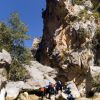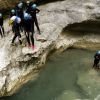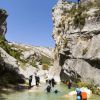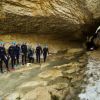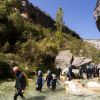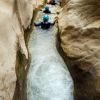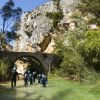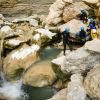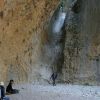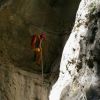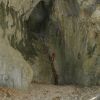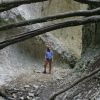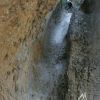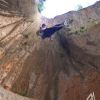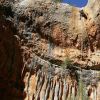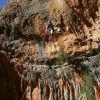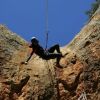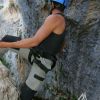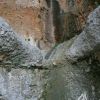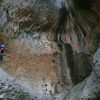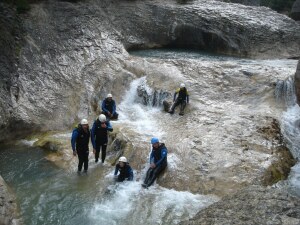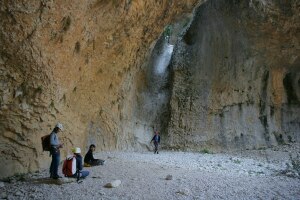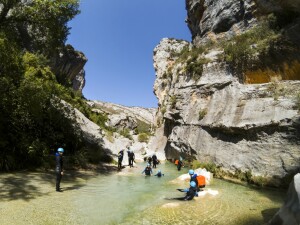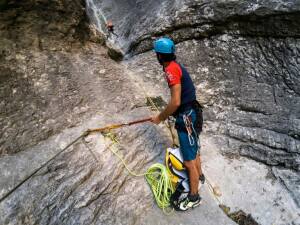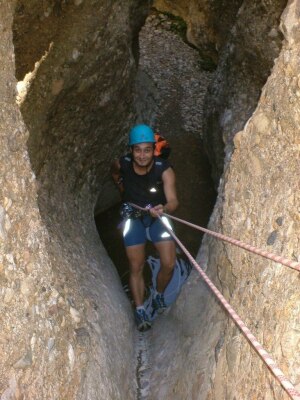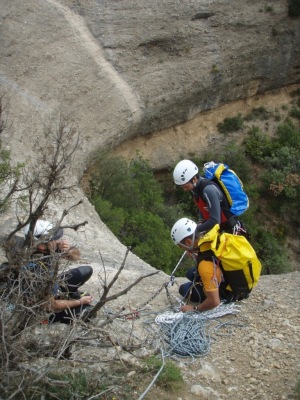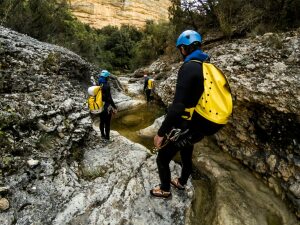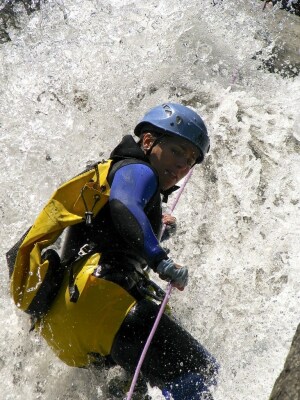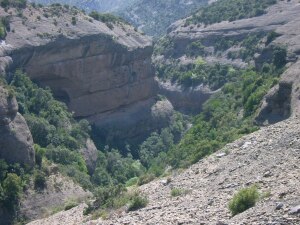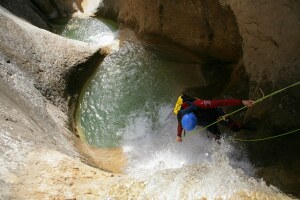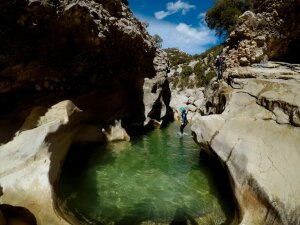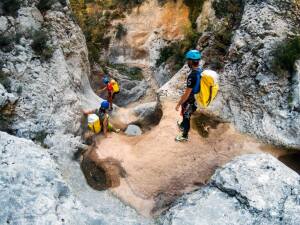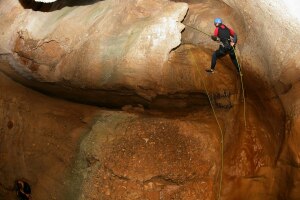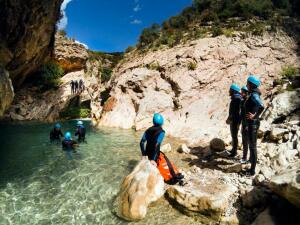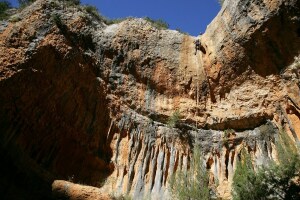Descenso de barrancos
River Vero Canyon
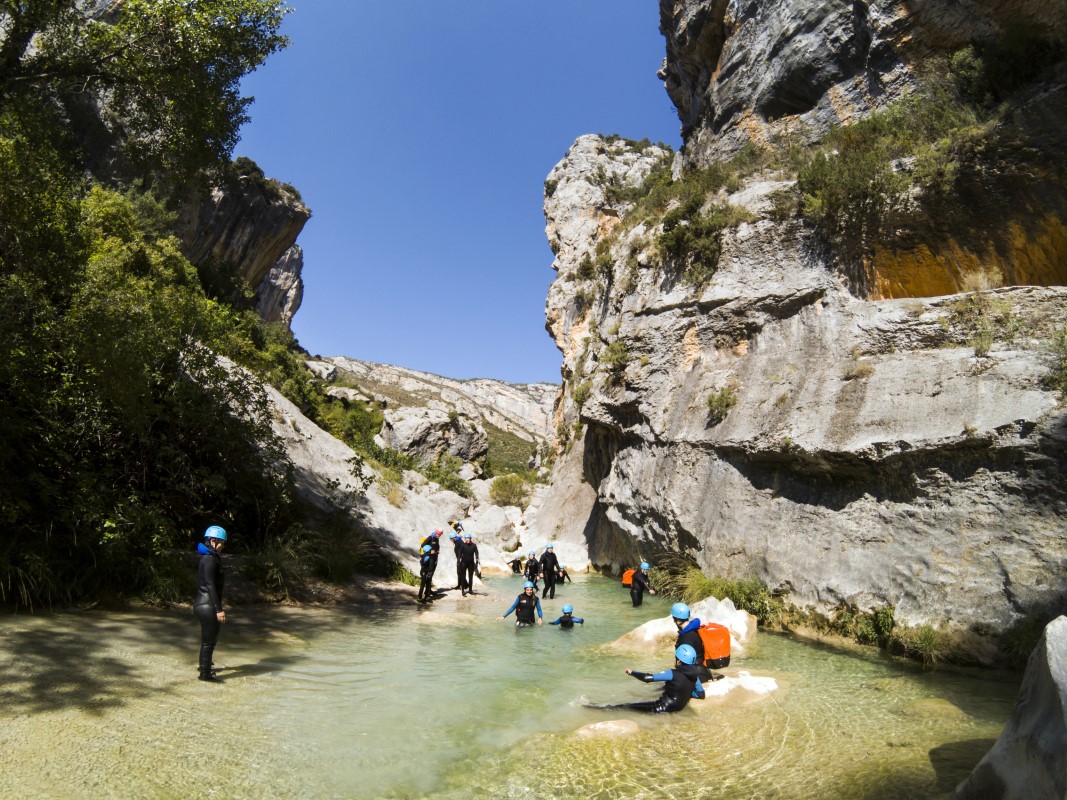
The River Vero canyon is one of the most spectacular within the NaturalPark of the Sierra de Guara, and one of the best known canyons in Europe. Its huge cliffs and many caves are ideal nesting spots for the birds of prey that inhabit the park, and are also home to many small wallcreepers (tichodroma muraria.) The canyon offers an attractive descent of around 6km in length, which is suitable for those in good physical condition and used to trekking.
The interior of the Vero canyon has long been known to the inhabitants of the area. There are traces of small, abandoned vegetable plots, mills and other buildings that made use of the water next to the river. There are also small chapels such as that of San Martin located at the point where the Vero meets the La Choca canyon, and impressive cave paintings dating back to pre-historic times.
These days, this canyon is the most popular in Guara, as it relatively easy, offers plenty of variety and is great fun; not to mention the magnificent views.
The River Vero, which receives practically all its water from the Berrala spring, has exploited the calcareous rock as it flows down the canyon, leaving behind an astonishing landscape. The river runs past the Lecina gorge; the Palomera cave; narrows such as the “Oscuros” where it almost disappears underground due to one of the largest rock piles (caos) in the whole of the park; the impressive cliffs in the Clusas and Villacantal gorges; huge boulders, enticing caves, quirky channels and deep pools of transparent water. This canyon offers a long and diverse descent.
Along the way there are openings to other canyons such as those of Portiacha and Basender, whose tributaries suddenly increase the water flow during and after storms. The Villacantal bridge, which leads towards Alquézar, awaits canyoners at the end of the route soon followed by the Fuendebaños bridge a little further along.
In a number of wet places such as around the springs or the hollows near the water, the large-flowered butterwort (pinguicola grandiflora) grows; a carnivorous plant that often shows the remains of unfortunate insects on its vividly coloured petals. At first glance the petals seem normal, but closer up a multitude of fine hairs can be distinguished, which secrete a sticky substance. When prey gets caught in the stickiness, a different gland then starts to secrete a liquid made up of acids and digestive enzymes that dissolve the softest parts of the insect. The same gland then reabsorbs this liquid, now rich in nutrients.
Downloads
Technical information
Approach: 10 minutes. From the River Vero car park, which is between the 16 and 17km mark on the road from Colungo to Arcusa. Nearest village: Lecina
Descent: 5 - 7 hours KM: 6km
Return: 35 minutes to Alquézar via the Footbridge Walk or the path that climbs up from the old electricity mill
Escape routes: Various along the canyon.
Pasolen/ Los Articazos
La Visera
Villacantal
Car combination: 1 car in the River Vero car park and 1 car in Alquézar.
Difficulty level: Depends upon the water flow and weather conditions.
Medium difficulty in summer.
Professional level as the river rises.
Minimum equipment requirements
- Full wetsuit and neoprene socks or canyoning shoes.
- Helmet
- 15m rescue rope
- Canyoning backpack
- Watertight barrel
- Due to the length the route, it is advisable to take along drinking water and a picnic.
Points of interest
- Schematic rock paintings in the Barfaluy shelter
- Caves with rock paintings in the stretches known as Gallinero and Lecina Superior
- The San Martin chapel
- Villacantal bridge
- Fuendebaños bridge
- Medieval villa of Alquézar
Photo gallery
Basender or Cruciacha
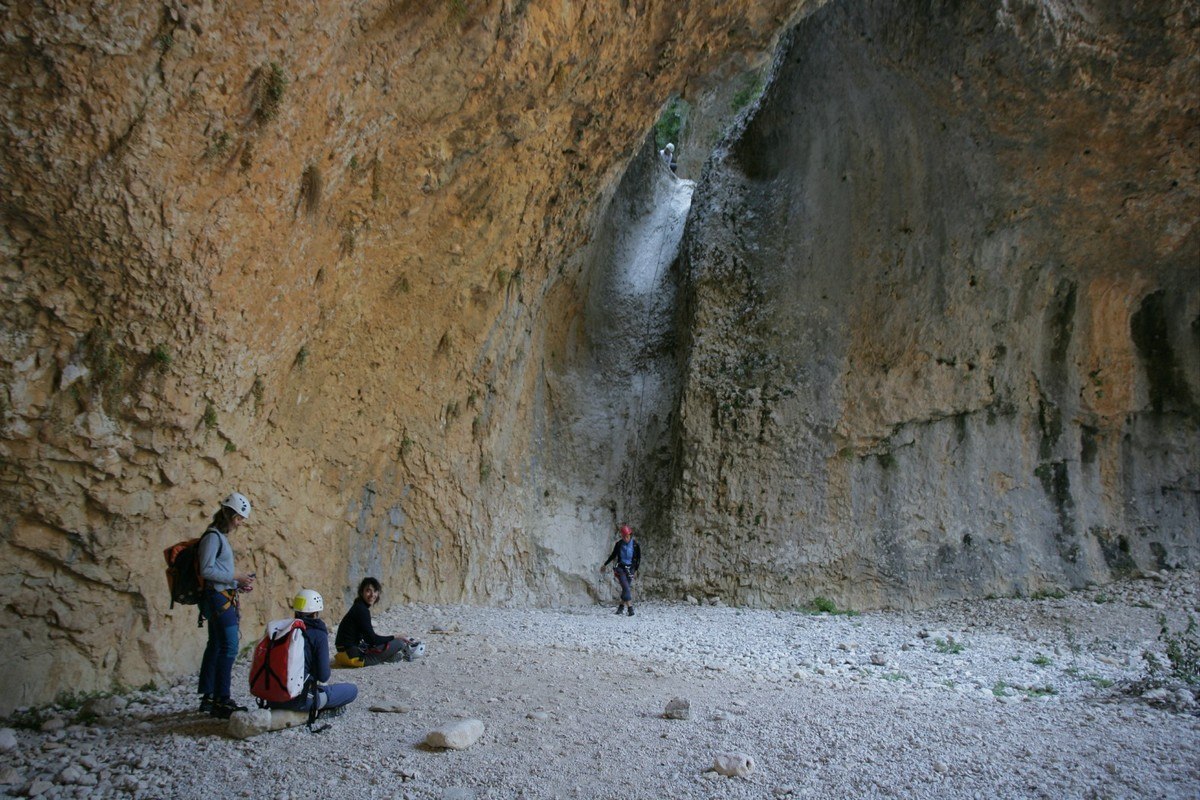
The Basender is actually the name of the higher part of the river before it enters the canyon. The true name of the final stretch described here is the Cruchiacha.
The Basender is a small tributary that flows into the River Vero. The shady riverbanks create an attractive vegetal environment, one of the highlights of which is the Pyrenean Violet, which flourishes in the spring.
This canyon offers a spectacular descent through narrow stretches excavated from calcareous rock. It is dry through most of the year, although its beauty is no less for having no water. This delightful route, with its curved chambers and understated recesses, offers wonderful displays of light and shade throughout the day. It is ideal for the beginners to the technique of abseiling and is essential for lovers of canyoning.
Technical information
Approach: 20 min Nearest village: Lecina
Descent: 2h - 2h:30 min KM: 650m
Return: 20 minutes from the River Vero car park
Escape routes: There are no escape routes from the fourth rappel onwards (even though it is difficult as climbing is necessary.)
Car combination n/a
Difficulty level: Medium throughout the year
Minimum equipment requirements
- Helmet
- Harness
- Anchoring sling
- Ropes
- Equipment for abseiling (figure-of-eight descender)
- 1 rope of at least 30m in length.
Puntos de interés
- Villa Medieval de Lecina
- Cuevas rupestres de Gallinero y Lecina superior
- Ermita de San Martín
Photo gallery
Portiacha
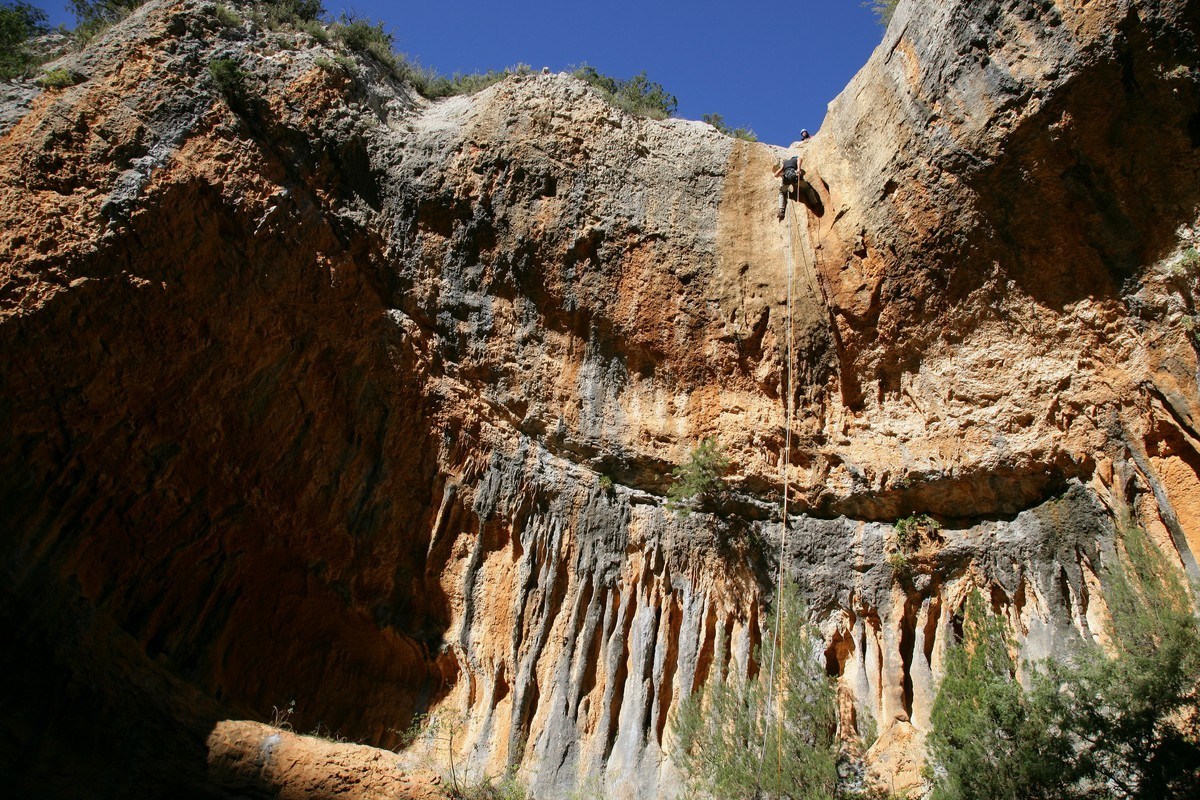
It includes two impressive “mid-air” rappels, each more than 30 metres high. The canyon is dry during most of the year, but can be quite damp. This canyon should only be tackled by those with good experience of abseiling techniques.
Birds of prey can be seen gracefully gliding over the canyon.
Technical information
Approach: 5 minutes. From the car park of Portiacha, a level area at the 18km mark on the road from Colungo to Arcusa. There are informative panels near the Mallata caves and a viewpoint overlooking the River Vero. Nearest village: Lecina
Descent: 1h 30 min - 2h:30 min KM: 250m
Retorno: 45 minutes from the car park of Portiacha. As you finish the descent of the canyon head back upriver until you reach the Portiacha car park. There is a footpath that leaves from the old mill, which heads towards the top of the slope and takes you to a bridge to cross the river. Take the track on the left-hand bank of the Vero that runs parallel to the river and cross the Argatín canyon. (Don’t go up to the car par located at the beginning of the Vero canyon.) Follow the path until it reaches the Portiacha car park.
Escape routes: There is a steep path to the left as you finish the first rappel .
Car combination n/a
Difficulty level: High throughout the year.
Minimum equipment requirements:
- Helmet
- Harness
- Anchoring sling
- Ropes
- Equipment for abseiling (figure-of-eight descender)
- 2 ropes of at least 40m in length.
- Additional protection material: Rope clamp (such as Shunt)
Points of interest
- Medieval villa of Lecina
- San Martin chapel
- Shelters of Mallata (Schematic art)
- Shelter of Arpán (Levantine art)
- Caves with paintings in Gallinero and Lecina Superior (Schematic art) on the right hand side of the River Vero.
Photo gallery
Chimiachas
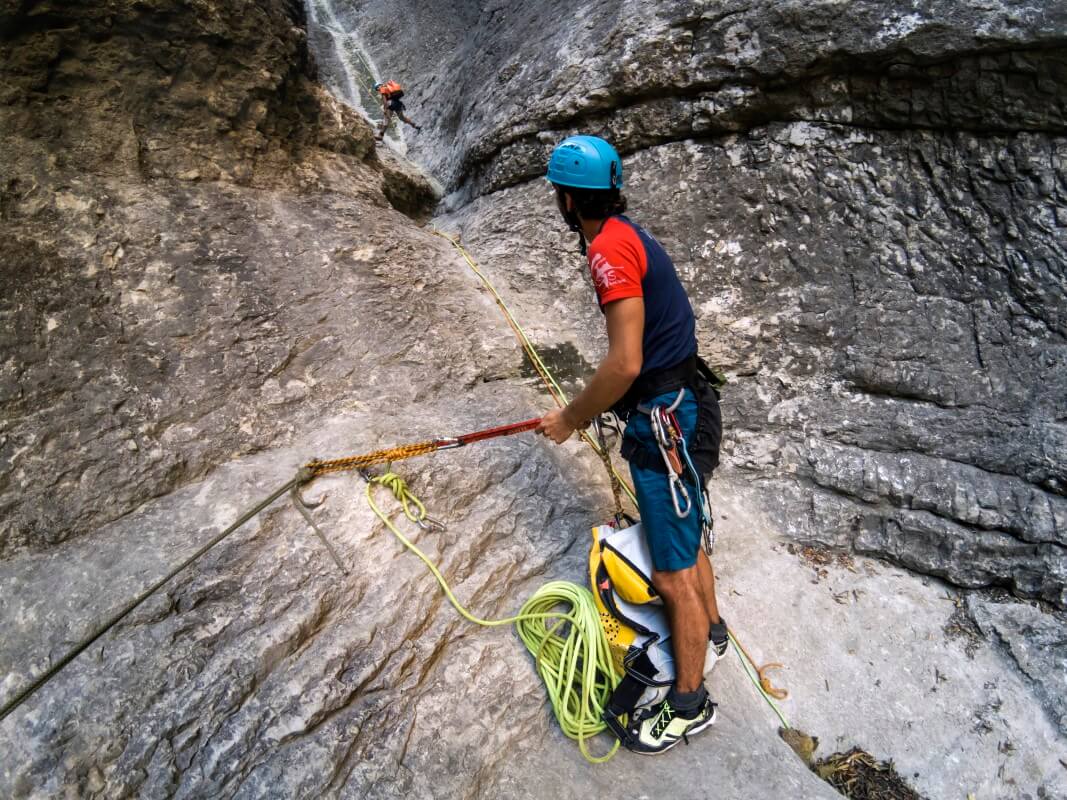
Chimiachas is one of the bigger tributaries to flow into the River Vero; it joins the larger river from the right-hand side of the canyon at a place known as La Cocineta. The beginning of the descent is in a lightly wooded environment, but this changes as the canyon gets narrower. At La Cocineta, where the two rivers merge, the canyon is almost impassable; however a small fissure provides the perfect point to abseil down the rock face.
This is a difficult and technical canyon, with very little water. It is demanding and its relative inaccessibility means that a full day is needed to explore it. However, it is, without doubt, worth the effort as it is one of the most spectacular canyons of the area.
This canyon is only suitable for people in peak physical condition and with a lot of experience of different abseiling techniques.
Technical information
Approach:
- 2 ½ hours from Alquézar (passing by Basacol and Quizans)
- 2 hours if the car is left on the track between San Pelegrin and the Meson de Sevil at the fork that goes directly up to Quizáns. There is a path marked with small rocks.
- Both paths lead to the top of the hill and from there just follow the signs for the path to the “Ciervo de Chimiachas” (the deer painting) and then to the river in the depths of the canyon.
Descent: 3 - 4 horas KM: 450m
Return:
- 2 hours, if following the path that leaves from Gran Visera
- 4 hours if descending the River Vero. Particular care is needed in rainy periods and the level of the river level should be checked carefully before commencing the descent.
Escape routes: After the first rappel, the only escape route of the descent is at Paso de los Articazos, which climbs up to Pasolen and Quizáns.
Car combination: No extra cars required if returning on foot to Alquézar.
Difficulty level: High level throughout the year and the use of a professional guide is highly recommended.
Minimum equipment requirements
- Helmet
- Harness
- Anchoring sling
- Ropes
- Equipment for abseiling (figure-of-eight descender)
- 2 ropes of at least 50m in length.
- Rope clamp (such as Shunt)
- Full wetsuit and neoprene socks or canyoning shoes if returning along the River Vero.
Points of interest
- Chimiachas and Quizan shelterss (cave paintings)
- Basacol pools
- Old shepherd’s huts made using dry-wall techniques.
- Bird watching, especially birds of prey


